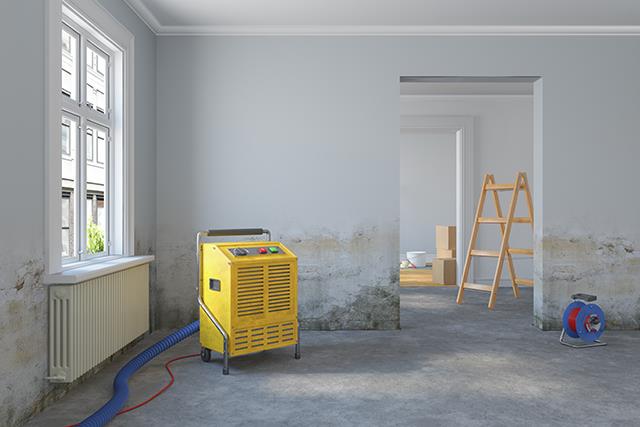Mould spores are everywhere: some are beneficial, some are destructive. Mould spores become a problem in your home when they find a warm, moist spot and begin to feed on organic matter and grow. Mould can be destructive and harmful to your health if it takes hold in your home.

READ: Eliminate bathroom mould and mildew: Effective removal techniques
Luckily, there are certain warning signs that mould is present to help protect your health and property before the situation becomes extreme. Learn these seven signs that you may have a mould problem.
How Often to Check For Mould and Remove It
After learning the warning signs, always do a thorough check of your home if you suspect mould growth. Cleaning mold infestation or removal of damaged surfaces should be done immediately. Mould won't easily go away when left on its own.
The most common moulds that most homeowners encounter can be classified into three categories: allergenic, pathogenic, and toxic.
Allergenic mould can require removal by a professional, but most allergenic mould can be removed with home disinfecting products.
Pathogenic mould can be controlled with disinfectants but large colonies require professional removal.
Toxic moulds are the most harmful and require a professional to kill the moulds and dispose of any affected materials.
Materials
1 bottle chlorine bleach; 1 bottle all-purpose cleaner; water
Instructions
Visible Discoloration or Staining
If you see grey, black, green, or bluish specks along grout lines, on walls, or other surfaces, it is most likely mould. Keep an eye out for pink, red, or brown streaks, as well. The texture of mould can be powdery, fuzzy, or slimy. Dark water stains on walls, floors, or ceilings usually indicate the presence of mould.
Action to remove the mould should be taken immediately whether you can do it yourself or need a professional.
Musty Odor
If your eyes are the first detector of mould, your nose runs a close second. Any whiff of a musty, earthy, or sour smell indicates that mould is present even if you don't see visible signs. When you detect an odor, become an investigator until you discover the source. If you don't see mould but still smell an odor, you may need a professional to investigate hidden colonies of mould in walls, crawl spaces, or along home foundations.
Once the source of the mould is found, it should be cleaned up or damaged areas removed immediately.
Damp Walls, Upholstery, Floor, or Cabinetry
If surfaces feel damp—walls, floors, furniture, cabinetry—the level of humidity in the home is too high. High humidity levels will encourage mould growth in visible and non-visible spots like inside couch cushions, mattresses, or walls.
To help reduce humidity, add a dehumidifier or run your HVAC system more frequently. Clean or remove any mold growth found.
Leaky Plumbing
Even a small, slow leak can add enough moisture to encourage mould growth. Check all plumbing connections inside and outside the house regularly, repair leaks as quickly as possible, and take steps to remove the mould.
Moisture Condensation
If you see droplets of water on walls, windows, windowsills, or around a refrigerator, freezer, or air conditioner coils, mould is sure to follow. Condensation occurs because the surfaces are typically colder than the air or other surfaces in the home.
Take steps to insulate or repair leaky spots around these areas or empty drip pans to help prevent mould growth.
Taste
If your cup of coffee tastes off, it could be there is mold in your coffee maker. Small appliances that use water and water dispensing systems in refrigerators are perfect breeding grounds for mould growth.
Regular cleaning and proper maintenance will help keep mould at bay.
Allergic Reactions
If someone in your family begins to show signs of an allergic reaction - sneezing, coughing, rashes - that won't go away, it could be because of mould. Consult with your physician and if mold exposure is the cause, take action to remove the mould.
Tips to Reduce Mould in Your Home
Check plumbing regularly for leaks and repair them quickly.
Reduce the humidity level in your home. Use circulating fans and vent fans in your kitchen and bathroom.
Wipe up spills and dry carpeting, upholstery, and laundry as quickly as possible.
Increase air circulation in your home.
Keep roofs repaired and gutters free of debris.
Clean and perform maintenance on appliances regularly.
READ: Get rid of mould without using harsh chemicals
How to get rid of mould
Home-Dzine provide says safety should be the most important concern when dealing with any type of fungus or mould. DO wear a dust mask, preferably one that incorporates replaceable carbon filters and DO wear gloves.
- Open all the windows and doors to allow cross-ventilation through the area where you will be working
- Where there is bubbling or peeling paint, use a paint scraper to remove all the loose paint
- Pour white spirit vinegar into a spray bottle and use this to liberally wet the infected area and leave for 2 to 4 hours to soak into the surface
- Use a stiff scrubbing brush to go over the infected area
- Rinse with clean water and allow to dry naturally
- If paint was removed from the wall, apply a plaster primer once the wall is dry and then paint over this
You can repeat the application of white spirit vinegar if there are still traces of mould or if the mould has been there for quite some time.
Source (Home-Dzine, TheSpruce)
Want all the latest property news and curated hot property listings sent directly to your inbox? Register for Property24’s Hot Properties, Lifestyle and Weekly Property Trends newsletters or follow us on Twitter, Instagram or Facebook.








